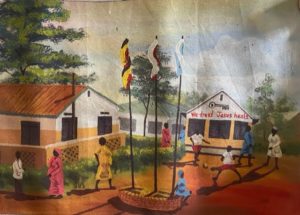Week 2, day 1 of maternity. I can’t believe it’s my last week in Kiwoko. I’m sad it is already coming to an end as I feel like I have so much more to learn. I’m glad I get to spend another week in maternity as it is a very busy ward in the hospital and you get the full experience there- mothers, babies, surgery, tropical diseases, genetic diseases, and pregnancy complications. Apart from the medicine, an interesting part of the day was related to language and translation. I worked with a medical officer that is not from this area of Uganda and, therefore, he did not know Lugandan. In Uganda, because of the influence of missionaries and educational services, English was adopted as the official language and remains the official language today even though a majority of the population does not speak it. There was an attempt to spread Swahili as the official language as it is African born, but many of the areas of Uganda did not agree with this as they were afraid it would ruin their local languages. There are 43 distinct languages in Uganda that can be broken up into four categories based on geography- Bantu, Nilotic, Central Sudanic, and Kuliak. Of the native Ugandan languages, Lugandan is the most widely spoken geographically. If you are in a city or doing business, people will usually be speaking English, Lugandan, or Swahili. If anyone has received a high school education, they will know some English. People that speak languages that are spoken geographically near each other can typically understand one another much in the same way that Portuguese and Spanish speaking persons can communicate without speaking each other‘s language. If people speak languages that are geographically separate from one another, however, it is nearly impossible to understand one another. This is the situation we found ourselves in today and this needed double translation for all of our patient encounters. Just as is in the US, I was left to wonder how much information was being conveyed properly to the patient and how much we were receiving correctly back. At the end of the day, I chalked it up as another reminder to always holistically assessing barriers with each patient.
Lugandan word of the day: okubaaga (“oh-koo-bog-uh”, noun, surgery)
Medical learning point of the day: G6PD deficiency is a condition that causes red blood cells to break down in response to a trigger. It is common in males and people of African descent. Triggers include infections, stress, fava beans, aspirin and other drugs. The symptoms include dark urine, fever, back pain, and pallor. While severe malaria can cause dark urine, consider G6PD if multiple people in the family develop dark urine while ill or if when they become ill they seem to fare worse than their peers.

